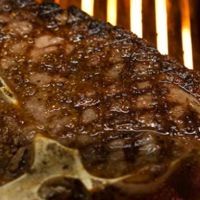The steak's the thing
Saturday 11 February 2012
• 3 min read

This article was also published in the Financial Times.
'The steak comes on its own, sir', the waitress explained as she took our order at 34, the newest Caprice Holdings restaurant, which opened right by the American Embassy in London's Grosvenor Square just before Christmas. 'Which side dishes would you like with it?'
This phrase, or words to the same purpose, is never far from the lips of any waitress in the rapidly growing number of steak restaurants. And it contains one of the four main reasons for their increasing popularity among customers and restaurateurs.
I had heard the first reason while sitting around the lunch table in Jerez, southern Spain, with Pontus Elofsson, the Swedish sommelier from Noma, Copenhagen, and Julian Serrano, who, from his vantage point as the executive chef of Picasso restaurant in the Belaggio Hotel, Las Vegas, has probably seen more steak restaurants open than anyone else.
'The great financial advantages of operating a steak restaurant', Serrano explained with almost a touch of envy in his voice, 'is that it is so easy to sell several extra side dishes to complete the plate and there is no real need to offer a reduced-price set menu. The steak's the thing, the minimum spend.'
And in offering this, restaurateurs are touching a deep nerve in many customers. Any cut of steak will always be among the most expensive items anyone purchases while food shopping. Many, however, believe that their cooking skills at home are not good enough to prevent its transformation into charred meat. They would rather leave it to the professionals.
This sentiment is widely appreciated by chefs and restaurateurs for although no steak generates the same gross profit as a bowl of pasta or soup, it will inevitably lead to a hefty bill, invariably supplemented by a bottle or two of good red wine.
This lucrative association was put into practice in New York as long ago as 1966 when Mike and Pat Cetta opened Sparks Steaks House, which still roars along under the slogan Cetta Brothers Steak Masters. Father and son Alan and Michael Stillman have followed suit with numerous branches of Smith & Wollensky in the US, while their younger British counterparts, Will Beckett and Huw Gott, are creating a similar atmosphere in their branches of Hawksmoor across London.
To this mix must be added one new, and possibly irreversible, factor, that many restaurateurs and hoteliers are turning to steak restaurants simply because they cannot find enough qualified and skilled chefs to open anything else.
There are some talented chefs in these steak restaurants but very few are doing their own butchering (which is obvious from the absence from these menus of the more inexpensive cuts); the grilling skills required are none too complicated; and, because so many simply follow the American tried-and-tested model of ice creams and pies, their desserts are predictably bland, a weakness of the otherwise reliable Goodman steak restaurants.
The waiting staff at 34, an L-shaped room that was once a bank, start with one great advantage and then create something memorable at the end of the meal. The food in between is pretty good, too.
Because the front door opens into the shallowest part of the room, the manageress on duty, either Laura Montana or Gina Glennon, can step out from behind her desk to greet you warmly and immediately. There is no time for any anxious customer to look around expectantly.
And, in a practice brought over from New York, the waiter asked me for my cloakroom ticket while he was processing my credit card, so that, he explained, 'we can have it ready for you at the door, sir'.
Equally impressive is the sight from the entrance of a huge, shiny parilla, an Argentine charcoal-burning grill fed on natural fuels that Tim Hughes, the group's executive chef, and Paul Brown, 34's head chef, have finally learnt to tame. Hughes explained to me that initially the extract directly above, while cooling the chefs, had been simultaneously and inadvertently blowing too much cool air over the meat as it rested. It has now been switched off, to the benefit of the meat and the customers, even if to the detriment of those cooking at the coalface.
34's culinary distinction is that it is not just the steaks that shine. We started with a pungent Cornish fish soup and a salad of potato, octopus and chorizo before sharing an Argentine sirloin and the best dish of the night, a cep, truffle and prosciutto lasagne, Brown's interpretation of the rich, vincisgrassi dish he had cooked while alongside Franco Taruschio at The Walnut Tree Inn near Abergavenny, Wales.
The desserts, particularly the poached winter fruits and the Seville orange ice cream, are fresh, well conceived and well executed.
The only black mark is the £2 cover charge, here levied 'at the table', according to the menu, although presumably not on the doggy bags that it says are also available. It is high time for the numerous London restaurateurs who still enforce, and profit from, this antediluvian charge to team up, before the Olympics, and abolish it for the benefit of all their customers.
34, www.34-restaurant.co.uk
Become a member to view this article and thousands more!
Premium
- 15,401 featured articles
- 274,903 wine reviews
- Maps from The World Atlas of Wine, 8th edition (RRP £50)
- The Oxford Companion to Wine, 5th edition (RRP £50)
- Members’ forum
Monthly
Annually
£99
Save 10% with annual membership
Professional
- 15,401 featured articles
- 274,903 wine reviews
- Maps from The World Atlas of Wine, 8th edition (RRP £50)
- The Oxford Companion to Wine, 5th edition (RRP £50)
- Members’ forum
- Commercial use of our Tasting Notes
£199
per year
